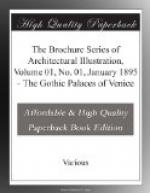A most important feature in recent educational work as applied to architecture is to be found in the formation of a number of classes, or ateliers as they are called, modelled in the main after those in Paris. They are all formed with the purpose of furnishing instruction in those elements of academic design which are unattainable in the routine experience of office practice. The details of arrangement for accomplishing this purpose vary somewhat in the different ateliers. We believe the first to be started was the one connected with the office of Messrs. Carrere & Hastings in New York. Here a limited number of students, both young men and young women, are received, and as a return for the instruction given them are expected to render such assistance in the regular work of the draughting-room as they can. This service is exactly similar to the “niggering,” as it is called, required by long-established custom of the younger men at the Ecole des Beaux-Arts at Paris, which is one of the most valuable features of the school work. In Paris by this method the younger students have an opportunity to come in personal and intimate contact with those more advanced, and have the benefit of working on larger and more important work than they are capable of undertaking unaided. In the new atelier a problem in design is given to the class, thus more than ordinarily equipped for the work before him.
[Illustration: VII. Portion of the Facade of the Ca D’oro, Venice.]
His work while abroad was systematic, well directed, and untiring, and no one of the succeeding scholars has labored to better advantage or accomplished more than he, although each in turn has had the example and experience of his predecessors as a guide and stimulus to increased endeavor. Mr. Blackall’s time was devoted largely to travel, together with the sketching and measuring of important work.
Since his return he has built up a successful and varied practice.
As an active member of the Boston Society of Architects and the first president of the Boston Architectural Club, he has done much to advance the best interests of the profession, both within its ranks and in its relations to the public. To nothing so much as to his faithful labors can the success of the Architectural Club be laid. He has made it the largest and most effective organization of its kind in the country, and the draughtsmen of Boston have every reason to be thankful to him for his unselfish devotion to their interests.
He has, for several years, been the permanent chairman of the Committee of the Boston Society of Architects, appointed to administer the Rotch Scholarship, and through his earnest work the opportunities open to its holders are being constantly increased.
(To be continued.)
* * * * *
Club Notes.




